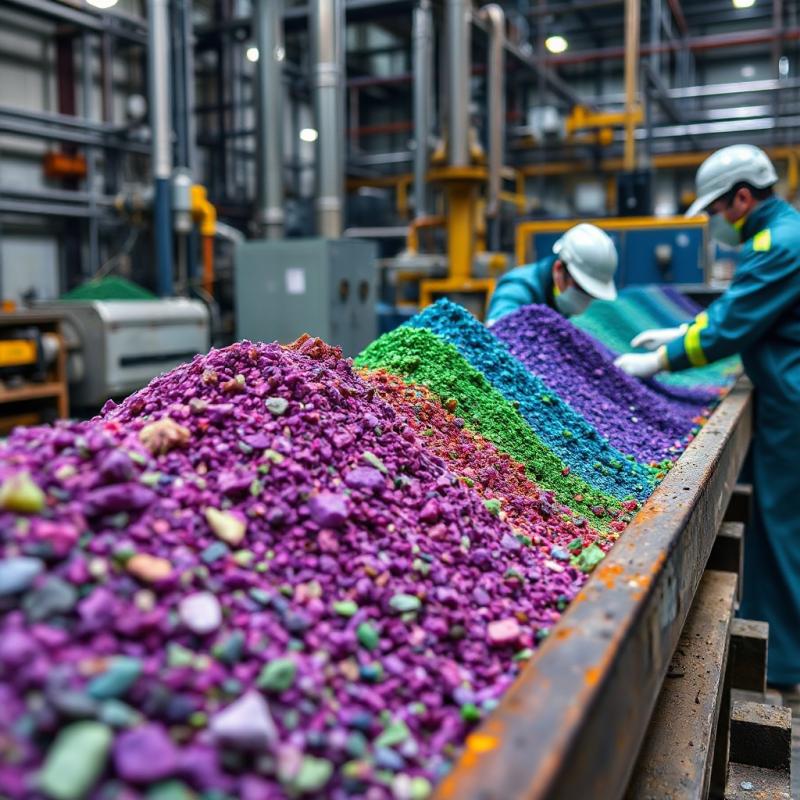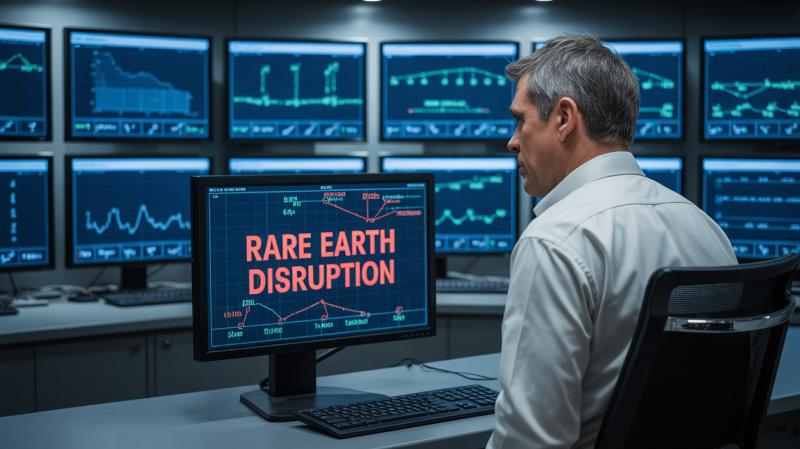
China's rare earth export limits disrupt global tech supply chains, causing price spikes and slowdowns in EVs, 5G, and IoT sectors reliant on these critical minerals.

Drivetech Partners
China's rare earth export restrictions on seven critical minerals are causing widespread disruption across global technology supply chains, triggering price spikes and production slowdowns. The controls on scandium, dysprosium, terbium, and other key elements have revealed dangerous vulnerabilities in industries ranging from telecommunications and IoT to electric vehicles, with China's dominant position giving it unprecedented leverage over global manufacturers.
Key Takeaways
Critical supply chains for EVs, smartphones, and 5G infrastructure face immediate disruption as China controls 60-70% of global rare earth production
Dysprosium and terbium shortages threaten 90% of EV motors, with inventory buffers projected to deplete by August 2025
Scandium price surges of 30% are delaying 5G infrastructure rollouts by 3-6 months in regions dependent on Chinese supplies
IoT sensor production lines in Europe have halted with 20% of orders delayed or cancelled due to rare earth magnet shortages
Western manufacturers are investing $12 billion in rare earth-free alternatives, but viable solutions aren't expected until 2027-2030

China's Rare Earth Dominance Creates Global Vulnerability
In response to the Trump Administration's 2025 tariff executive orders, China's strategic decision to restrict exports of seven critical rare earth elements has sent shockwaves through global technology and mobility sectors. The country controls 60-70% of global rare earth production, 90% of refining capacity, and over 80% of U.S. rare earth imports. This market dominance gives Beijing unprecedented leverage over international supply chains.
The export restrictions affect raw materials and finished products containing scandium, dysprosium, terbium, samarium, gadolinium, lutetium, and yttrium. These seemingly obscure elements are actually fundamental building blocks for modern technology, from smartphones to electric vehicles.
Perhaps most concerning is China's new licensing system, which grants Chinese authorities visibility into global technology supply chains, enabling targeted disruptions. European manufacturers report that only 25% of export license applications for rare earth magnets are being approved, creating bottlenecks that can't be quickly resolved.

Mobility and EV Sector: Production Lines at Risk
The automotive industry faces the most immediate threat from rare earth shortages. Neodymium-iron-boron (NdFeB) magnets, which require dysprosium and terbium for heat resistance, are irreplaceable components in 90% of electric vehicle motors. Industry analysts project current inventory buffers will be exhausted by August 2025, threatening imminent production line shutdowns.
The impacts are already visible across major automotive markets:
European manufacturers including VW, BMW, and Renault have reported temporary production halts
U.S. automakers Ford and Stellantis have already experienced production pauses
In India, EV launches face 2-3 month delays with production costs rising by 8%
Even hybrid vehicles and conventional cars with electric power steering systems face supply risks as the shortage extends beyond pure EVs. The industry is investing $12 billion in rare earth-free alternatives, including Tesla's work on induction motors and Toyota's development of ferrite-based motors, but mass-market solutions remain years away.
Telecommunication Infrastructure: 5G Deployment Slowing
The rollout of 5G networks globally faces significant headwinds due to rare earth restrictions. Scandium-doped aluminum nitride (ScAlN) is critical for high-frequency filters in 5G base stations, with no readily available substitutes that offer comparable performance.
Export delays are threatening manufacturing of bulk/surface acoustic wave (BAW/SAW) filters, essential components that ensure signal quality and prevent interference in cellular networks. The result is emerging signal degradation issues and slower network deployments.
Telecom operators are experiencing a double hit: component shortages creating 3-6 month delays in infrastructure projects, plus a 30% surge in scandium prices (from $270/kg to $350/kg) since export restrictions began. These increased costs will ultimately affect the pace of 5G adoption, particularly in regions heavily dependent on Chinese supplies, including parts of the EU, India, Southeast Asia, and Africa.
IoT and Industrial Technology: Energy Efficiency Crisis
The Internet of Things sector faces unique challenges from the rare earth shortage. Terbium and dysprosium are essential for the high-performance magnets used in industrial IoT sensors and edge devices. As of June 2025, inventory shortages have halted European sensor assembly lines, with 20% of orders delayed or cancelled.
Manufacturers are turning to ferrite magnets as substitutes, but this compromise comes at a significant cost: 10-16% higher power consumption in IoT deployments. This energy penalty undermines sustainability goals for smart city and industrial applications, creating a dilemma for companies balancing production needs against environmental commitments.
Major IoT providers including Siemens, Honeywell, Bosch, and Schneider Electric are accelerating efforts to diversify their supply chains, but alternative sources from Australia, the United States, and Canada aren't expected to reach meaningful scale before 2028-2030.
Consumer Electronics: Performance Compromises
Smartphone manufacturers and consumer electronics producers are facing significant disruption. RF front-end modules and vibration motors in smartphones rely on scandium and dysprosium, while Wi-Fi routers and access points need rare earth-based filters for reliable signal processing.
Component shortages are slowing production at major OEMs in Japan, Korea, and the U.S. Storage disk drive production, which relies on dysprosium-enhanced magnets for actuators, is particularly affected, with analysts projecting 18% fewer HDDs produced globally in the second half of 2025.
To maintain production, manufacturers are switching to less efficient materials, resulting in compromised performance. Devices produced without optimal rare earth components may experience reduced battery life, decreased signal quality, and diminished durability - a step backward in technology advancement that consumers will ultimately notice.
Price Volatility and Market Impact
The restrictions have triggered dramatic price spikes across rare earth markets:
Dysprosium spot prices hit $450/kg in June 2025, up 32% from $340/kg in March
Scandium prices surged 30% following the export restrictions
Terbium experienced a 22% price increase since controls began
This volatility is compressing margins for original equipment manufacturers (OEMs), who are increasingly passing costs to consumers. If current export controls persist through 2030, the long-term implications will be severe, including recurring production stops, model launch delays, and global vehicle price increases of 5-10%.
Technology production will remain constrained, especially for applications requiring high-frequency or high-efficiency components. While innovation in alternative materials will accelerate under pressure, viable solutions will lag behind immediate industry needs for years.
Strategic Responses and Future Outlook
Western nations are responding to the crisis with strategic stockpiling efforts and attempts to establish alternative supply chains. The EU, U.S., and India are investing in rare earth mining and processing facilities, but meaningful production is still 3-5 years away from viability.
The crisis is forcing a fundamental reevaluation of global manufacturing footprints, with potential reshoring of production away from regions dependent on Chinese rare earths. Companies are also accelerating recycling initiatives for rare earth recovery, though these efforts cannot meet near-term demand.
The rare earth restrictions have transformed what was once an obscure supply chain concern into a top-level strategic issue for governments and corporations alike. This shift represents a new reality where critical minerals are recognized as powerful geopolitical leverage in international relations.
Sources
Metal Miner - China's Grip Still Chokes Global Supply
CSIS - Consequences of China's New Rare Earths Export Restrictions
Amazing Magnets - China's 2025 Rare Earth Export Controls
EE Times - China's Rare Earth Controls May Impact Chip Industry
Automotive News - China Rare Earth Restrictions Explained
Economic Times - Global Supply Panic: China's Rare Earth Export Freeze






